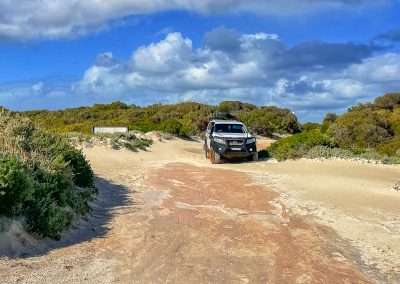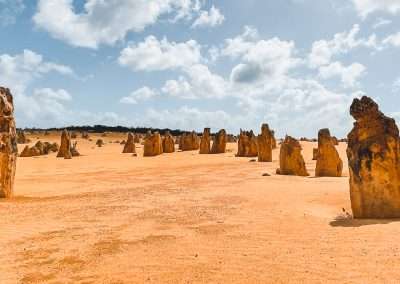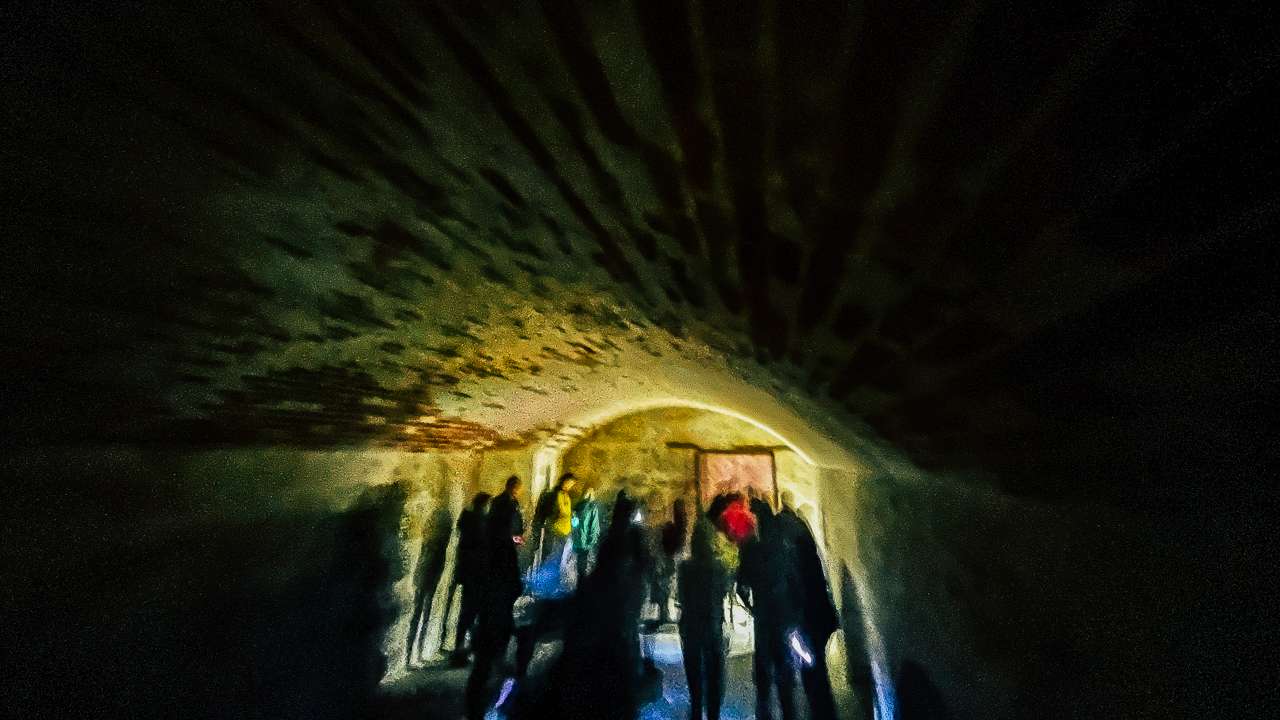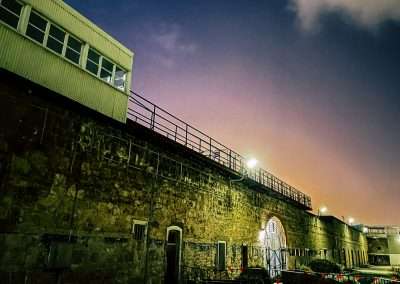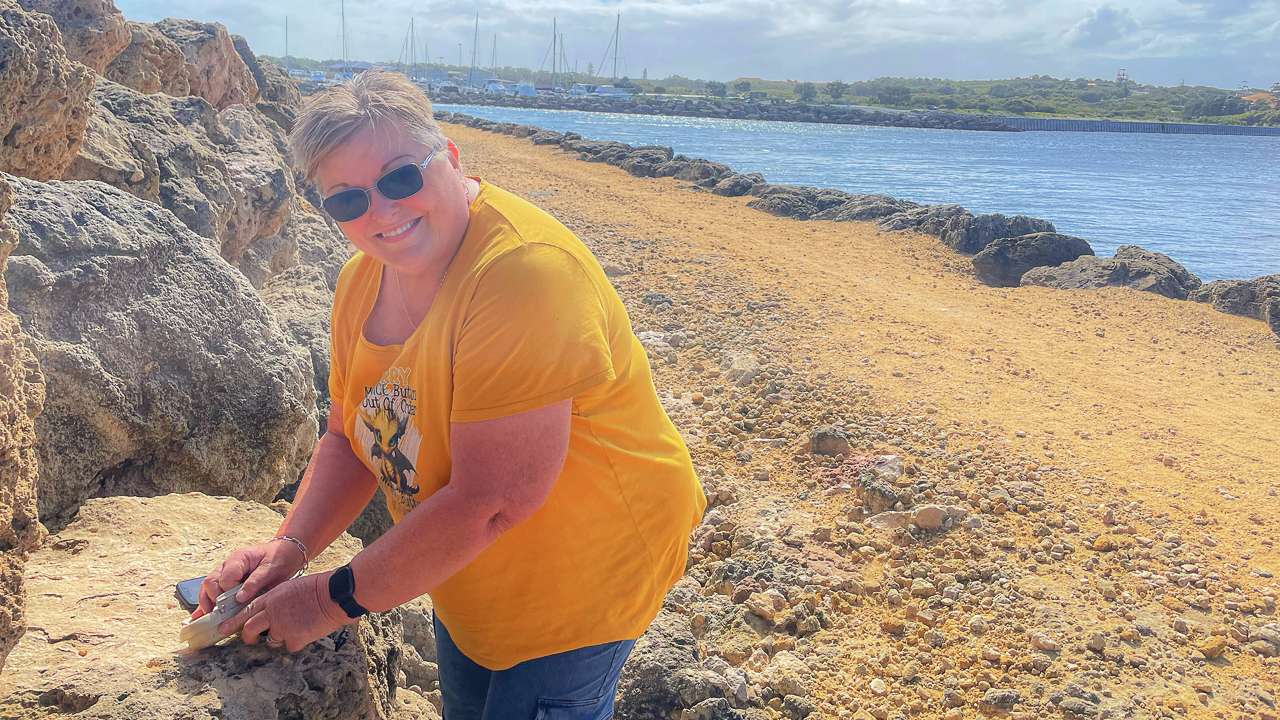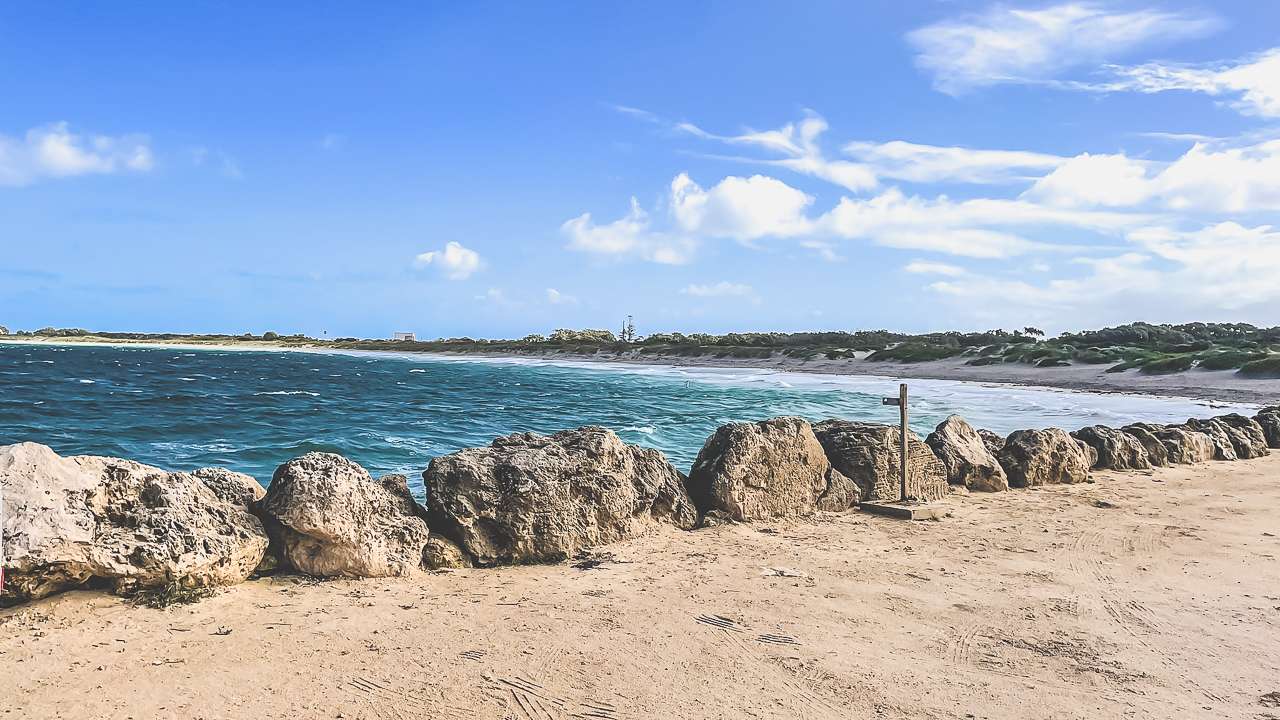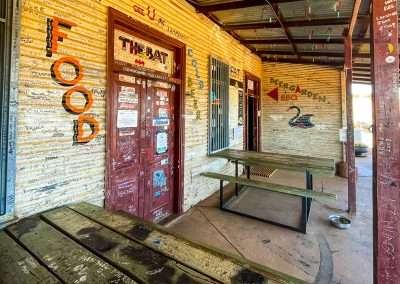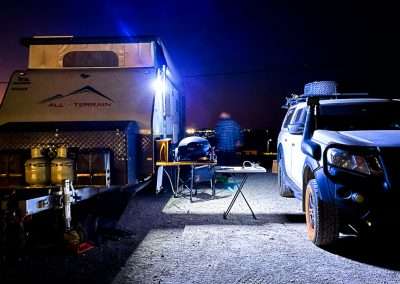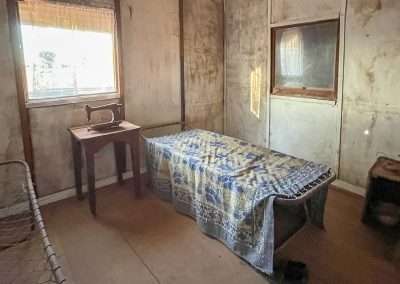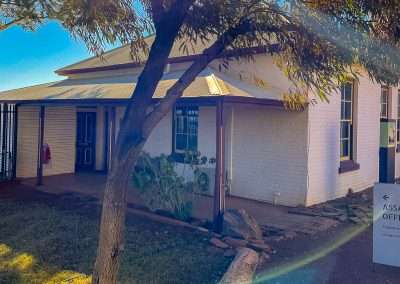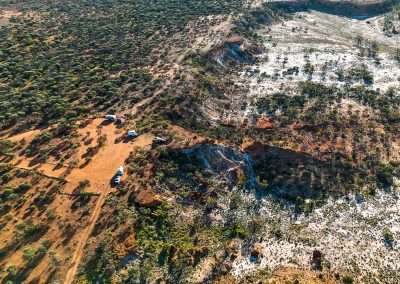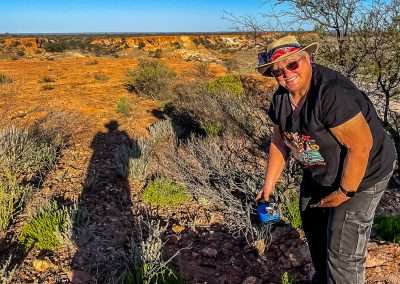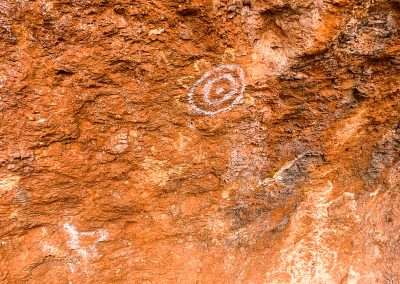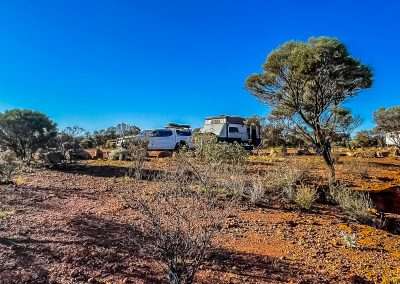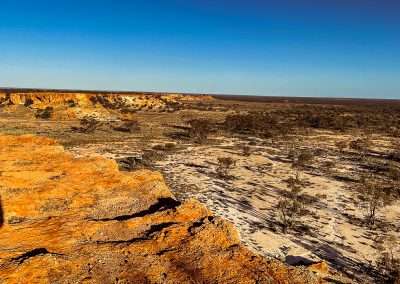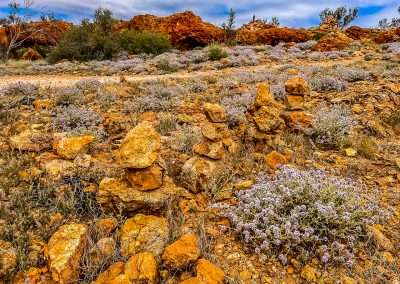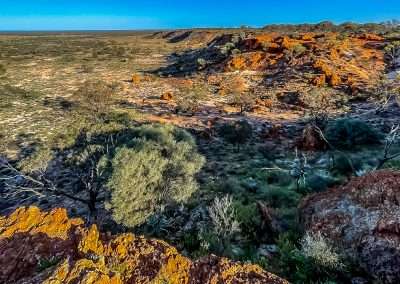
We Visited The Pinnacles Desert: Awesome Day Trip From Perth
We Visited The Pinnacles Desert: Awesome Day Trip From Perth
We visited the Pinnacles Desert Western Australia on day trip just 2 hours from Perth. Nambung National Park’s stunning limestone formations are as interesting as they are completely weird. When you’re visiting Western Australia, a day trip to The Pinnacles Desert is an absolute must.
Just a short two hour drive north of Perth this unique landscape is like stepping onto another planet. Imagine towering limestone formations scattered across golden sands under a big blue sky. This place truly has to be seen to be believed. So if you’re up for a little road trip hop in the car pack some snacks and let’s get going! Here’s what you need to know for a day trip to The Pinnacles plus a few things we didn’t and now do.

The Pinnacles
Table Of Contents
- What Are The Pinnacles?
- Getting To The Pinnacles Desert From Perth
- The Journey Begins: Perth to Cervantes
- Arriving At The Pinnacles Desert
- The Perfect Time To Visit
- What to Do at the Pinnacles Desert
- Wildlife at Nambung National Park
- Sunset and Stargazing at The Pinnacles
- Tips for a Great Day Trip to The Pinnacles Desert
- Wrapping Up: A Pinnacle Experience!
- FAQs Frequently Asked Questions About The Pinnacles Western Australia
- How long does it take to get to the Pinnacles from Perth?
- Do I need a 4WD to get around the Pinnacles Desert?
- What should I bring with me for a day trip to the Pinnacles?
- Is it worth sticking around for sunset at the Pinnacles?
- Are there any facilities at the Pinnacles?
- Can I see any Aussie wildlife while I’m there?
What Are The Pinnacles?
The Pinnacles Desert is a natural attraction located within Nambung National Park, around 200 kilometres north of Perth. These ancient, natural limestone formations rise out of the desert floor, some reaching up to four metres in height. Formed over millions of years the pillars are actually made from seashells. Remnants of an ancient seabed that once covered the area. Weathered by wind, sand and time they now stand as beautiful monoliths. Creating a surreal and almost otherworldly landscape.
It’s the type of spot that leaves you in awe with thousands of photo opportunities. But it’s more than just a pretty landscape it has cultural and scientific significance too. Indigenous stories link the Pinnacles to Dreamtime legends and scientists still study the formations to understand how they developed over millennia. Reading through the information boards in the visitors I got the impression that scientists aren’t completely sure how the Pinnacles formed. They have their theories but aren’t deadset sure.
Getting To The Pinnacles Desert From Perth
Getting to the Pinnacles from Perth is part of the fun. It’s roughly a two hour drive each way and you’ll travel along the scenic Indian Ocean Drive, which offers beautiful coastal views. Make sure you leave early if you want to enjoy a full day there without rushing.
Top Tip: If you’re not keen on driving there are plenty of day tour operators in Perth that can take you there and back. But honestly a self drive is a fantastic way to go. It gives you the freedom to explore at your own pace and pull over for photos whenever something catches your eye.

The Pinnacles Desert
The Journey Begins: Perth to Cervantes
After leaving Perth, you’ll soon find yourself on the open road, heading north towards Cervantes, a charming coastal town that’s also the gateway to the Pinnacles. Cervantes is only about 17 kilometres from the Pinnacles, so it’s an ideal spot for a quick stop to stretch your legs, grab a bite and maybe even dip your toes in the ocean before you head inland to the desert.
There are also a few cool things to check out in Cervantes itself. There are also a few cool things to check out in Cervantes itself. If you have the time, Lake Thetis is worth a quick look. It’s one of only a few places in the world where you can see stromatolites, ancient life forms that give us a glimpse into the early history of life on Earth. They’re sort of like rock-like microbial reefs and they’re thought to be some of the oldest life forms on the planet.
We Called In At Two Rocks WA: A Great Little Village On The Coast
On the way to The Pinnacles we called in at Two Rocks for a coffee and a look around. Two Rocks in Western Australia is a top spot for a laidback day out. Only about 60 kilometres north of Perth. This little coastal town has a mix of history and beautiful scenery. Named after two prominent rocks in the ocean just offshore it’s got a fair bit of character and a few quirky sights that make it a fun place to explore.
A Quick History of Two Rocks, WA
Two Rocks started out as a quiet fishing village but gained a bit of fame in the 1970s when developer Alan Bond came up with a plan to turn it into a major tourist destination. Alan Bond might have been as dodgy as a three dollar note but I somehow manage to like the bloke despite his dodginess! He built the Yanchep Sun City project which included a marina and a massive Atlantis Marine Park.
This marine park featured dolphin shows, an underwater tunnel, and even a giant statue of King Neptune, which has become a bit of a local icon. Atlantis Marine Park drew crowds and had a good run, but it eventually shut down in the late 1980s. Now while the park may be gone King Neptune’s statue still stands proudly and has become a bit of a quirky landmark.
Things to Do in Two Rocks
Whether you’re keen for a bit of sightseeing, a dip in the ocean, or a casual feed by the sea, Two Rocks has a few top spots worth checking out.
Visit King Neptune’s Statue
You can’t visit Two Rocks without checking out this massive statue of King Neptune. Built as part of the old Atlantis Marine Park, the statue has a fair bit of character and is one of those “only in Australia” type attractions. It’s a bit kitschy but well worth a photo op. Over the years, it’s become a beloved symbol of the area, and you’ll see plenty of locals and tourists alike stopping by to snap a pic.
Relax at Two Rocks Marina
The Two Rocks Marina is a prime spot for a relaxing stroll, and if you’re a fan of fishing, it’s a great place to throw in a line. There are some beautiful ocean views here, and you might even spot a few dolphins cruising around. The marina area also has a few shops, so you can grab a bite or an ice cream while you enjoy the views.
Have a Swim or a Surf at Two Rocks Beach
The beaches around Two Rocks are quiet and stunning. They’re ideal for a bit of sunbathing, swimming, or just enjoying the coast. The waves here are usually pretty mellow, making it a good spot for beginner surfers or for just mucking around in the water. It’s also a great beach for families—there’s plenty of space to spread out, and the water’s generally safe for a dip.
Explore Yanchep National Park
While technically not in Two Rocks, Yanchep National Park is only a short drive away and is well worth a visit. You’ll find heaps of Aussie wildlife here, including koalas and kangaroos. The park has some great walking trails and even a few caves you can explore. It’s a fantastic spot to get out into nature and see a bit of the local flora and fauna.
Two Rocks may be small, but it’s got a lot of charm. With a quirky history, laid-back beaches, and that unbeatable coastal vibe, it’s the perfect little getaway from the hustle and bustle of Perth. So next time you’re up for a roadie, pack the car, bring some mates, and head up to Two Rocks for a good time by the sea.
Leeman’s Boat Landing Memorial
When we were at Two Rocks we called in and checked out the Leeman’s Boat Landing Memorial. It’s a simple but important tribute to the area’s history and the resilience of the people who settled there. Abraham Leeman was a Dutch sailor marooned in the area back in 1658. Part of an expedition led by the Dutch East India Company, Leeman and his crew were abandoned after their ship, the Waeckende Boey, sailed off without them.
Leeman came ashore with his men searching for survivors of the ship Vergulde Draeck. The Dutch East India Company (VOC) ship, Vergulde Draeck foundered in 1656, to the north of Two Rocks. Stranded with limited resources, Leeman eventually managed to reach Batavia (modern-day Jakarta) with only a small number of his original crew – a feat that’s still considered impressive even today.
The memorial marks the site and recognises the legacy of Leeman’s survival, as well as the area’s later development as a fishing town. It’s a great spot to pause and soak up some local history while you’re exploring Leeman’s Boat Landing. For locals and visitors alike it’s a reminder of both the town’s rugged beginnings and the spirit of adventure that still defines the area.

Leemans Boat Landing
Arriving At The Pinnacles Desert
Once you enter Nambung National Park (small entrance fee applies) it’s only a short drive from the gate to the Pinnacles Desert. You can either park your car and explore on foot or take the drive through track. It’s an easy drive, we saw as many Corollas on it as we did 4WDs. The track allows you to get up close to the formations without even leaving your vehicle. However we got out and went for plenty of walks amongst the Pinnacles as you just have to. When you see them you’ll understand what I mean.
Whether you’re walking or driving, the sight of these towering limestone pillars set against a backdrop of blue sky and golden sands is truly breathtaking. It feels almost otherworldly, as though you’ve stepped onto the set of a sci-fi movie. The pinnacles rise out of the ground in all shapes and sizes and as you wander, you can let your imagination run wild. Some look like ancient towers, while others resemble strange creatures frozen in time.

Pinncacles Desert National Park Information Board
The Perfect Time To Visit
The Pinnacles Desert is open year round, but the best time to visit depends on what kind of experience you’re after. If you want to avoid the heat, spring (September to November) is ideal. This is also the wildflower season in Western Australia and the landscape along the drive comes alive with colourful blooms. We visited in September and the weather was fantastic. About 20 degrees celsius with a breeze.
If you don’t mind a bit of warmth summer evenings offer the chance to see the Pinnacles under a blanket of stars. The desert is an official dark sky area making it perfect for stargazing.

Pinnacles In Nambung National Park
What to Do at the Pinnacles Desert
You might think there’s not much to do in a desert full of limestone pillars but there’s more than enough to keep you occupied. Here are a few things that will make your visit even more memorable.
- Drive the Pinnacles Desert Discovery Trail
This 4-kilometre loop allows you to drive slowly around the desert. Along the way, there are several stopping points where you can get out, take photos and enjoy the formations up close. - Walk the Desert View Trail
If you’re keen for a stroll, there’s a 1.5-kilometre walking trail that weaves through the Pinnacles. The walk allows you to get up close and personal with the formations and provides more opportunities to marvel at their intricate shapes. - Check Out the Pinnacles Desert Discovery Centre
The Discovery Centre is a small but informative stop. It provides fascinating information on how the Pinnacles were formed, local Indigenous culture and the types of flora and fauna in the park. The building itself is magnificent. It looked like something that the famous American Architect Frank Lloyd-Wright designed. I’ve been to one of his buildings “Taliesin West” near Scottsdale Arizona and the pinnacles Discovery Centre has the same kind of feel as that. - Photography Galore
Every angle of the Pinnacles offers something different. Try different times of the day for the best lighting, but sunrise and sunset provide the most dramatic lighting for photographs. - Picnic Among the Pinnacles
If you’ve brought some snacks or a packed lunch, you’re in luck! There are picnic tables and restrooms near the entrance to the desert. Just be sure to keep an eye out for any cheeky crows looking to steal your lunch. - Geocaching
There’s a geocache hidden within Nambung National Park out amongst the Pinnacles. We managed to find it. On the drive to the Pinnacles from Perth there are a LOT of geocaches. we pulled in found maybe half a dozen of them. If we’d had time we’d have picked up lots more.

Found A Geocache In Nambung National Park
Wildlife at Nambung National Park
Keep an eye out for wildlife while you’re here. You might spot kangaroos, emus, or even a curious echidna if you’re lucky. If you’re a bird lover, bring your binoculars—the area is home to a variety of native bird species, including galahs, cuckoos and black-shouldered kites.
Sunset and Stargazing at The Pinnacles
One of the best-kept secrets of the Pinnacles is how incredible they look at sunset. The golden hour bathes the landscape in a warm, reddish glow, transforming the pillars into shadowy silhouettes. And if you’re game to stay until dark, you’re in for a real treat: the Pinnacles is one of the best spots in Western Australia for stargazing.
Being away from the city lights, the skies here are inky black and the stars shine with unmatched clarity. If you’re there on a clear night, you’ll see constellations like the Southern Cross, as well as planets and maybe even the occasional shooting star.

Great Lunch Spot Down A 4wd Track At Hansens Bay Beach Near Cervantes WA
Tips for a Great Day Trip to The Pinnacles Desert
Here are some tips to make sure your day trip to the Pinnacles is one to remember:
- Bring Plenty of Water and Sunscreen: The desert can get hot and there isn’t much shade around.
- Pack a Picnic or Snacks: While there are food options in Cervantes, it’s nice to have a bite to eat as you enjoy the view.
- Start Early: Leave Perth early in the morning to get the most out of your day.
- Wear Comfortable Shoes: You’ll likely be doing a bit of walking, so comfy footwear is a must.
- Bring a Camera: The Pinnacles is a photographer’s paradise and you’ll want to capture every angle.
- Respect the Wildlife and Environment: Take nothing but photos and leave nothing but footprints.
Heading Back to Perth
After a day of exploring, it’s time to make the drive back to Perth. It’s a good idea to start heading back before it gets too dark. Kangaroos are known to be more active near the road at dusk and after sunset. If you’re feeling hungry on the way home there are some great places along the way to stop for fish and chips or a pie.
By the time we got back to Perth we were feeling a mix of awe and wonder. The Pinnacles were great however the drive along the coast was also bloody magic. We were also a bit tired from all the walking we had done. The Pinnacles Desert really is one of those places that has to be seen to be believed and it’s sure to be a highlight of any trip to Western Australia.
Fish and Chips from the Lobster Shack to Hansen Bay: A Perfect Lunch in Cervantes
Before heading back to Perth we called into the Lobster shack Lobster Shack at Cervantes for some fish and chips. Known for its fresh seafood especially WA’s famous rock lobster this spot is popular with locals and visitors. But while the lobster’s definitely the star you really can’t go wrong with a classic fish and chips lunch. Crispy golden batter, a generous serve of chips and some tartare sauce – they do it right!
Lunch At Hansens Bay
Once we had our fish and chips we went on short drive down to Hansen Bay. We went out of town a little bit and followed a dirt track for about a kilometre or so. This beautiful beach was a great place to settle in for a laid back beach lunch. The water was nice and calm but too cold in September for a swim! There’s plenty of space to set up a picnic spot but we just sat on the tailgate of the ute as we’re all about the easy option. Watching the waves and feeling the sea breeze with a pack of fish and chips to eat? Doesn’t get much better. If you’re lucky you might even spot a few dolphins in the distance. Hansen Bay and the Lobster Shack together make for a proper Aussie lunch experience by the coast – simple, fresh, and downright tasty. Perfect for a cruisy afternoon by the sea.
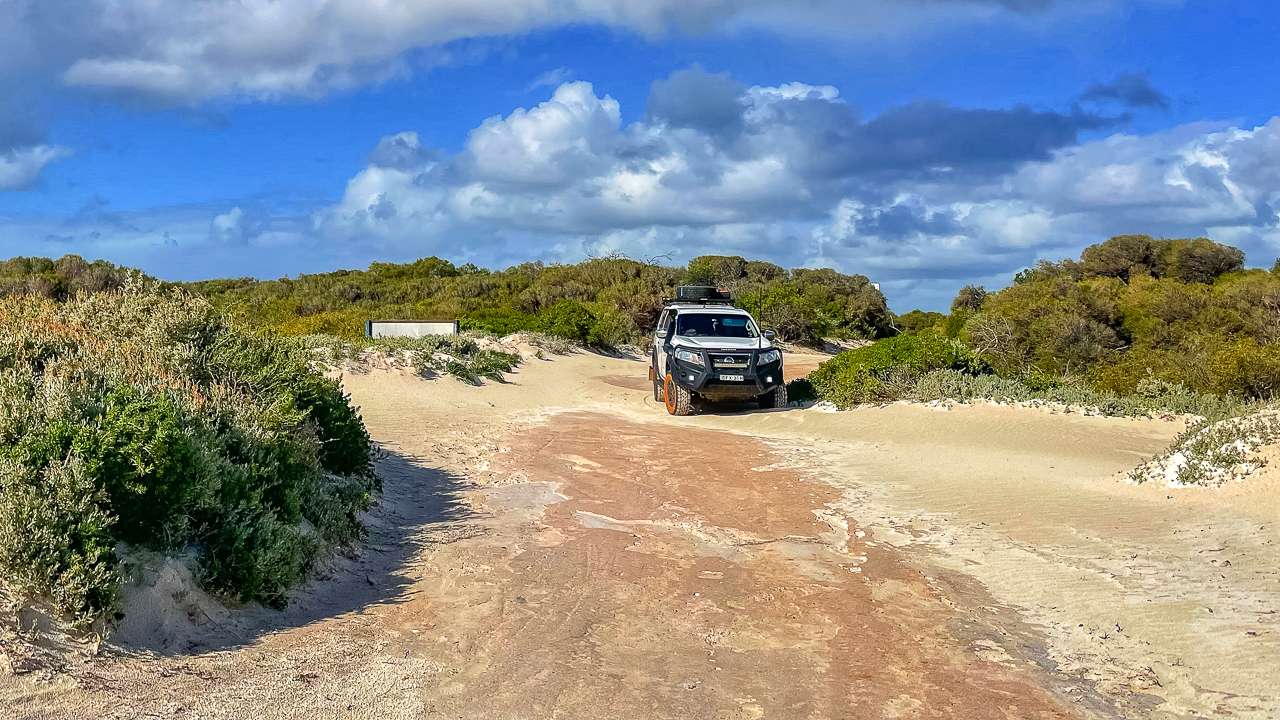
Down A 4wd Track At Hansens Bay Beach Near Cervantes WA
Wrapping Up: A Pinnacle Experience!
A day trip to The Pinnacles Desert from Perth is one of those bucket list experiences that you’ll remember forever. Whether it’s the unique landscape, the serene atmosphere, or simply the feeling of stepping away from the hustle and bustle of the city, The Pinnacles offers a taste of the extraordinary right here in Western Australia. So next time you’re in Perth and looking for an adventure. Grab a mate, jump in the car and set off to explore this unforgettable slice of WA. It’s worth every kilometre.
Our Day Trip From Perth To The The Pinnacles Western Australia Photo Gallery
Down A 4wd Track At Hansens Bay Beach Near Cervantes WA
Down A 4wd Track At Hansens Bay Beach Near Cervantes WA
Close Up Of One Of The Rock Formations In Nambunng National Park WA
Close Up Of One Of The Rock Formations In Nambunng National Park WA
Great Lunch Spot Down A 4wd Track At Hansens Bay Beach Near Cervantes WA
Great Lunch Spot Down A 4wd Track At Hansens Bay Beach Near Cervantes WA
FAQs Frequently Asked Questions About The Pinnacles Western Australia
How long does it take to get to the Pinnacles from Perth?
Do I need a 4WD to get around the Pinnacles Desert?
What should I bring with me for a day trip to the Pinnacles?
Is it worth sticking around for sunset at the Pinnacles?
Are there any facilities at the Pinnacles?
Can I see any Aussie wildlife while I’m there?


